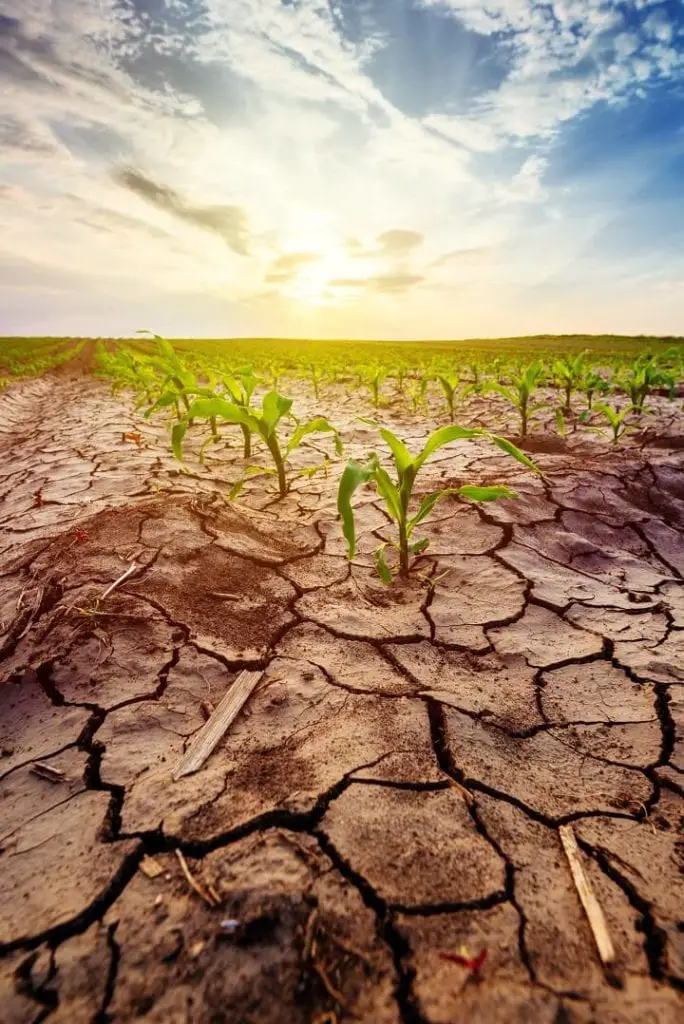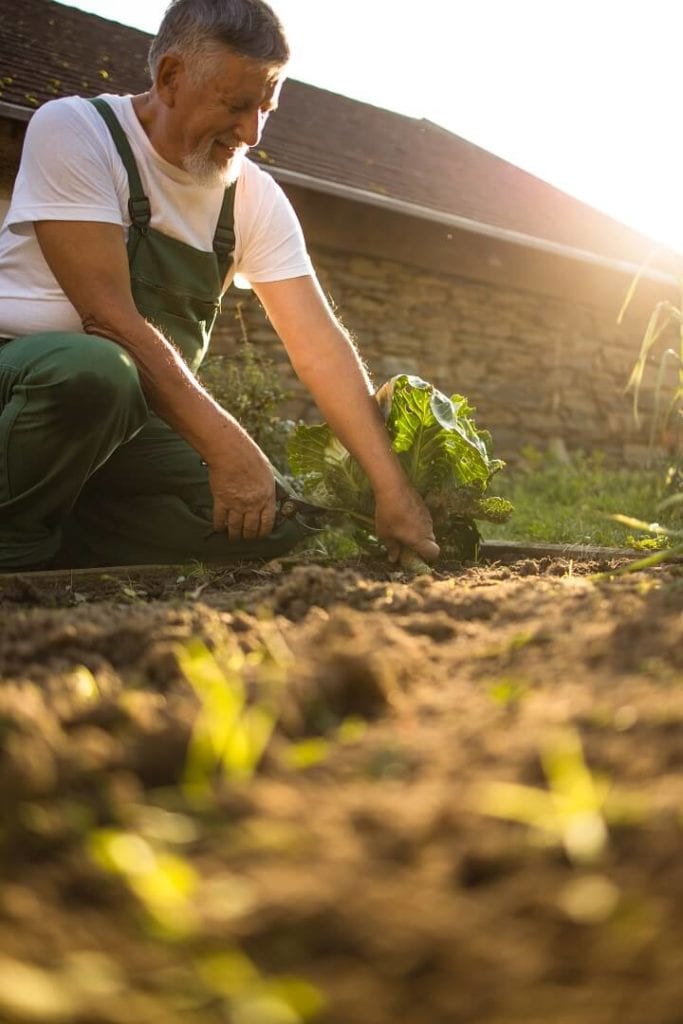[ad_1]
Estimated reading time: 8 minutes

Drought tolerant plants are an excellent choice for a survival garden no matter where you live. Periods of little to no rain have plagued gardeners for centuries, even in mild climates. The month of July, in particular, always proves to be an obstacle for garden and herb crops.
You can garden successfully even in hot climates that are prone to periods of drought if you choose the proper plants to cultivate and grow them in a way that helps them retain moisture and flourish.
While fruit is the most difficult crop to grow during a drought, a vast array of vegetable and herb plants can survive drought conditions and still generate a robust harvest from the survival garden.
Want to save this post for later? Click Here to Pin It On Pinterest!
Top 40 Drought-Tolerant Plants
The following vegetable and herb crops are highly suitable for growing in drought conditions and in hot climates in general.
- Amaranth
- Black Diamond Watermelon
- Black-Eyed Peas – also known as field peas and cowpeas
- Borage
- Calendula
- Cassava
- Chia
- Chickpeas
- Corn
- Cucumbers
- Dandelion
- Dragon Fruit
- Echinacea
- Eggplant
- Golden Oregano
- Grapes
- Groundnut
- Heatwave Tomatoes
- Jerusalem Artichokes – sunchokes
- Lavender
- Lima Beans
- Mullein
- Mustard Greens
- Okra
- Peppers
- Pole Beans
- Pomegranate
- Pumpkin
- Quinoa
- Rosemary
- Sage
- Savory
- Sorghum
- Spring Radishes
- Summer Squash
- Sunflowers
- Sweet Potatoes
- Tarwi
- Thyme
- Zucchini

Drought Crop Growing Tips
Soil
It all begins with the soil, no matter how amazing the seeds or starter plant are that you want to put in the ground. The nutrition of the soil is especially important when planning on growing successfully during times of drought.
To have healthy soil that will retain moisture during periods of little to no rain, make sure that the levels of nitrogen, phosphorus, and potassium are optimal. The exact amount of each nutrient needed in the soil will be specific to each plant that you are growing. If you are trying to keep fruit trees and bushes alive during a drought, ample amounts of these three essential nutrients will be necessary.
Because livestock manure contains a large amount of soluble salt, use it only sparingly as compost in a survival garden to survive a drought. Skipping the manure entirely may be advisable if keeping plants alive during a drought is a major concern. Manure compost has many advantages, and I have used it a lot when growing various types of plants, but it does have disadvantages, as well.
Arid soil, or soil that will become arid during a long drought, will have a high alkaline content. Lowering the pH levels in the soil to keep all plants, especially fruits, healthy will be necessary. Infusing the soil with sulfur is one tried-and-true way to bring down the pH level.
Sun Protection
The intense heat of the sun can cause both tip burn and scalding of plants during a drought. Using a tarp, dark sheet, or some other type of awning or protective covering can help prevent crops from being scorched and ultimately, killed.
Watering
It is never a good idea water plants from the top down, especially during a drought. Using a drop hose (soaker hose) that waters the plants at ground level should help prevent scorching during times of intense heat and no rain.
Always water crops in the survival garden in the morning or at dusk to further prevent them from getting scorched by the application of water as heat is raging all around them. While the amount of water each crop requires varies, it is the general rule of thumb that all plants need roughly two inches of water per week to survive.
The drought tolerant vegetable plants on the list above are prone to developing deep root systems which both help them sustain themselves when water is stunningly lacking yet the sun is intense.
Young plants will typically fare a lot better during a drought than recently planted seeds. If a drought hits or is anticipated to hit not long after you plan to plant seeds in the garden, consider sprouting them into young plants indoors before planting them. Once the plants are nearing the flowering stage, they are more likely able to withstand intense sun and a lack of natural watering.
If you absolutely need to get seeds into the ground right away to start cultivating a survival garden, consider using seeds that are quick growing and can be harvested in a shorter amount of time, like zucchini and spring radishes.

Drought Plant Selection And Growing Plan
Grouping vegetable plants with similar watering needs together or engaging in vegetable and herb companion planting may help your survival garden even during a drought. This method of crop cultivation can help prevent overwatering of some plants while focusing on providing the optimal amount of moisture for a guild or grouping of plants.
This type of a growing plan is also known as “intercropping.” Farmers in Africa have used the intercropping process with great success, especially when growing corn, sweet potatoes, and cassava together.
Cowpeas
While cowpeas are not known as a traditional garden crop in the United States, farmers in both Brazil and Nigeria cultivate this hardy seed extensively. Cowpea is highly capable of thriving even in regions prone to drought where farmers are forced to consistently deal with parched garden soil due to receiving less than 12 inches of rainfall annually.
As long as the cowpea seeds are able to garner enough moisture to take root they should be able to survive a drought. The stalks and stems of the cowpea plant are not consumed by humans but can be used as a nutrient dense type of livestock fodder.
Another wonderful benefit of growing either cowpea, corn, or Jerusalem artichokes during a drought is the shade they cast onto other crops planted nearby in the survival garden.
Chickpea, also not a typical garden crop in the United States, is heralded as one of the most vital legum grain crops around the globe. Farmers in unusually dry regions of China and throughout South Asia invest their cultivation time heavily in chickpeas because of its drought durable nature.
Chia
Chia and Tarwi may be the two most unusual survival garden plants on this list – but they are definitely worth attempting to grow as part of a drought food security plan.
During ancient times, Aztecs communities in Central America widely grew chia for its edible and tasty seeds because of its ability to not only survive but thrive during periods of acutely dry weather.
In our modern world, a growing number of farmers in Guatemala, Nicaragua, Bolivia, and Ecuador are harkening back to the olds ways and planting chia as part of their drought harvest plan.
Chia seeds are full of rich protein and can either be eaten whole as a snack or tossed into a casserole or soap, ground into a flour, or pressed to make a cooking oil.
Tarwi
Tarwi is a type of a pea plant that develops a vibrant blue blossom as it grows into maturity. The Incas and Bolivian farmers largely considered tarwi as one of their most reliable and drought resistant survival crops. This is a relatively quick growing crop that is now also being grown increasingly by sub-Saharan African farmers seeking a more drought resistant crop, as well
Tarwi seeds, like chia, boast a high percentage of protein. They can be eaten whole and raw or cooked, ground into a flour or pressed to make a superbly flavored cooking oil.
Beans
Beans area “go to” drought-resistant crops throughout Latin and Central America. Agriculture scientists are consistently and diligently working to develop even more drought-resistant bean varieties to further the nutrient-rich crop options to feed people in drought-prone areas of the world.
The Centa-Eac bean (named for the National Center for Agricultural and Forestry Technology where the development research for the bean strain took place) is one of the newest hybrid drought-resistant beans that was created by crossing red beans and black beans over the course of several years.
Farmers who struggle annually with drought in Nicaragua are growing the INTA-Tomabu red bean that was also created by agricultural scientists specifically to withstand periods of very little rain.
Preparing to grow a survival garden that is able to produce a sustainable harvest during a drought should be an essential part of any homesteader’s or prepper’s food security plan. While you can stockpile seeds explicitly to plant during a drought or for an SHTF event, it is far better to incorporate such plants into your annual survival garden now.
The success rates for the crops as well as the development of the soil will likely be much higher if you have experience cultivating both the plants and the dirt they grow in ahead of when there is a dire need to rely upon their harvest.
Heirloom seeds should be purchased for the drought-resistant survival garden plants whenever feasible. Saving some seeds from each year’s crops will help to better ensure you have a variety strain that is hardy to your environment and growing soil. Proper storage of any type of seeds is essential to its potential germination and ultimately, the yield the plant that grows from it will produce, as well.
Like this post? Don’t Forget to Pin It On Pinterest!
Up Next:
[ad_2]
Source link
Get more stuff like this
in your inbox
Don't Be Left Unprepared
Thank you for subscribing.
Something went wrong.



